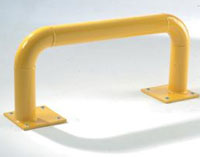Types Of Protection Barriers
One type of protection barrier is used to keep drivers safe. Another makes it easy for parking lot owners to control access to their lots. Other types of barriers allow sidewalks to be marked and secured.
Road Protection Barriers
One of the primary uses of barriers is to keep drivers safe when they're in their vehicles. Many roads have different features that can be hazardous. Whether it's a dip, a sharp turn or an area where lanes converge with each other, accidents can be significantly reduced when drivers are made aware of these hazards far enough in advance. Because of the bright colors that they're available in, protection barriers do an excellent job of alerting drivers to the fact that they need to pay attention.
While being warned about a potential hazard will keep most drivers safe, there is still the possibility that a driver may occasionally hit one of these barriers. Although this may seem like a significant downside, there are two ways that protection barriers are able to successfully deal with this issue. The first is that some barriers are designed to completely absorb a car's impact. This is done through a combination of the barrier being made from lightweight material and having a joint that allows it to stand back up after being knocked over. The other method is that even when a barrier is made from a material like steel, it's specifically designed to minimize the damage caused by a collision.
Protection Barriers for Parking Lots
There are several ways that protection barriers can be used in parking lots. They include:
- Preventing entry when a lot is closed
- Keeping unwanted vehicles out of reserved spots
- Making it easier for drivers to park without going too far
Although business owners want customers to have easy access to their parking lot during operating hours, this doesn't mean they want strangers to have access to the lot at night. Protection barriers make it easy to keep a lot accessible during the day but closed at night.
The barriers used to control access to a lot and those that keep unauthorized vehicles out of paid parking spots operate in the same way. When access needs to be denied, these protection barriers are simply raised up in the air. Because they're made from steel, there's no way for a car to drive over them. When it's time to provide access, the barrier is simply lowered. In the case of barriers that are designed to make it easier for drivers to park, these remain in an upright and fully visible position.
Sidewalk Barriers
Protection barriers used around sidewalks have two main purposes. The first is to mark areas that may be somewhat difficult to see. The other is to make it clear to vehicles that they can't access an area that's a sidewalk. Successfully keeping vehicles off of a sidewalk will leave pedestrians free to safely enjoy walking. The variety of sidewalk barrier styles that are available also means they will add to the look of an area.

